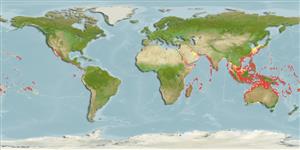Common names from other countries
Lớp phụ Cá sụn (cá mập và cá đuối) (sharks and rays) >
Myliobatiformes (Stingrays) >
Aetobatidae (Pacific eagle rays)
Etymology: Aetobatus: Greek, aetos = eagle + Greek, batis, batidos = a ray (Raja sp.) (Ref. 45335).
More on author: Kuhl.
Environment: milieu / climate zone / depth range / distribution range
Sinh thái học
Biển; Thuộc về nước lợ Sống nổi và đáy; Mức độ sâu 1 - 100 m (Ref. 89467), usually 20 - 25 m (Ref. 89467). Tropical
Indo-Pacific: East Africa, including the Red Sea to Hawaiian Islands and French Polynesia.
Length at first maturity / Bộ gần gũi / Khối lượng (Trọng lượng) / Age
Maturity: Lm 155.0, range 150 - 160 cm
Max length : 300 cm WD con đực/không giới tính; (Ref. 114953); common length : 180 cm WD con đực/không giới tính; (Ref. 6871); Khối lượng cực đại được công bố: 200.0 kg (Ref. 89467)
This large species is distinguished by the following characters: dorsal surfaces with a dark greenish grey base coloration, variably white spotted, rarely ocellated; different NADH2 gene structure; relatively long tail with mean total length 281% DW, mean anterior cloaca to tail tip 230.2% DW; stinging spines relatively long with mean length of first spine 9.7%DW; teeth plates are in a single row, those in the lower jaw chevron-shaped; pectoral fin radials about 102-116, excluding proterygial radials anterior of eyes; 99-101 total vertebral centra, including synarcual (Ref. 84291).
Found in coastal waters (Ref. 45255), including estuarine habitats (Ref. 89467). Can grow over 3 m disc width and up to 880 cm total length if the long tail is undamaged (Ref. 30573). Feeds mainly on hard-shelled bottom-dwelling invertebrates such as hermit crabs, whelks, oysters, clams and large molluscs (Ref. 9862, 114953), crustraceans, worms, octopuses and fishes (Ref. 89467). Ovoviviparous (Ref. 50449). Size at maturity for males 100-130 cm WD, females ca. 150-160 cm WD and size at birth highly variable 18 cm to at least 50 cm WD. Females produce litters up to 10 pups, usually 4 or less (Ref. 114953). Common catch of the demersal tangle net, bottom trawl, inshore gillnet and, to a lesser extent, demersal longline fisheries. Utilized for its meat and cartilage (Ref. 58048). Tail used as a decorative item (Ref. 27550). Flesh edible (Ref. 30573).
Life cycle and mating behavior
Maturities | Sự tái sinh sản | Spawnings | Egg(s) | Fecundities | Ấu trùng
Exhibit ovoviparity (aplacental viviparity), with embryos feeding initially on yolk, then receiving additional nourishment from the mother by indirect absorption of uterine fluid enriched with mucus, fat or protein through specialised structures (Ref. 50449).
White, W.T., P.R. Last, G.J.P. Naylor, K. Jensen and J.N. Caira, 2010. Clarification of Aetobatus ocellatus (Kuhl, 1823) as a valid species, and a comparison with Aetobatus narinari (Euphrasen, 1790) (Rajiformes: Myliobatidae). pp. 141-164. In P.R. Last, W.T. White and J.J. Pogonoski (eds). Descriptions of new sharks and rays from Borneo. CSIRO Marine and Atmospheric Research Paper no. 32. (Ref. 84291)
IUCN Red List Status (Ref. 130435)
CITES (Ref. 128078)
Not Evaluated
Threat to humans
Traumatogenic (Ref. 4690)
Human uses
cá để chơi: đúng
Các công cụ
Special reports
Download XML
Các nguồn internet
Estimates based on models
Preferred temperature (Ref.
115969): 24.8 - 29, mean 28 (based on 194 cells).
Phylogenetic diversity index (Ref.
82804): PD
50 = 0.6250 [Uniqueness, from 0.5 = low to 2.0 = high].
Bayesian length-weight: a=0.01000 (0.00244 - 0.04107), b=3.04 (2.81 - 3.27), in cm Total Length, based on all LWR estimates for this body shape (Ref.
93245).
Mức dinh dưỡng (Ref.
69278): 3.6 ±0.5 se; based on size and trophs of closest relatives
Thích nghi nhanh (Ref.
120179): thấp, thời gian nhân đôi của chủng quần tối thiểu là 4.5 - 14 năm (Fec assumed to be <100).
Fishing Vulnerability (Ref.
59153): Very high vulnerability (85 of 100).
